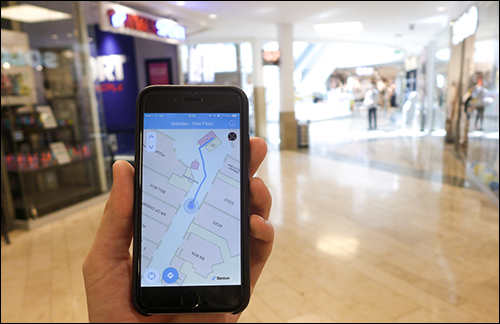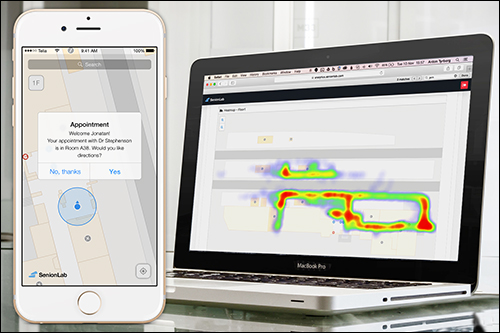Jul 06, 2016A mall and a hospital in the United States have each installed a beacon-based solution provided by Senion to provide location-based services to shoppers, visitors or patients via a smartphone app, and to track traffic patterns and those individuals' behavior. The Swedish firm began offering a Bluetooth Low Energy (BLE) beacon version of its StepInside system approximately two years ago, and has since seen its technology installed at a half-dozen companies around the world, primarily in malls, though non-disclosure agreements prevent it from naming those customers.
The company says it is now in discussions with about 10 U.S. health-care providers, as well as several large mall chains around the world. Its goal is to install its technology at those locations during the coming year.
Senion, launched in 2010 by several Ph.D. candidates from Linköping University, initially offered a Wi-Fi-based version of the StepInside system for the retail market. The company specializes in combining data from smartphones' built-in sensors (altimeters, accelerometers, magnetometers and gyroscopes) with beacons to provide location identification, in order to help identify where a smartphone—and thus its owner—is located within a complex environment, such as a crowded shopping mall.
The company's name is derived from two words, sensor and fusion. That, according to Marcus Andersson, Senion's VP of marketing and sales, illustrates that the system fuses data from sensors already installed in phones with information from the beacon transmissions to create what it calls a smooth "blue dot," which can show the position of an individual moving through the area on a map of a facility, similarly to GPS. This feature provides wayfinding for individuals in malls, passengers in an airport, or doctors and medical personnel seeking colleagues at a health-care facility.
The StepInside software, Andersson says, is designed not only to identify a phone's location (based on responses to a beacon transmission), but also to predict where that person is going, the floor on which he or she is located, and how quickly he or she is moving. Typically, he explains, Senion sells its solution to systems integrators and resellers so that those companies can develop a solution for a mall or other end user employing their own apps.
The technology not only enables a company to send location-based content to smartphone users via the app, but also collects analytical data regarding behavioral patterns, such as where crowds do and do not gather within a mall, and how long they congregate in specific areas. "It provides you with traffic patterns, where there are sections where people go, and where they don't," Andersson says. The data collected can then be used to determine what content will interest a particular individual, based on where he or she is going at any given time.
So far, the technology is in use at a hospital in San Luis Obispo, Calif., and at a mall in San Francisco. Both the hospital and mall worked with Phunware, an app developer in Austin, Texas, to create smartphone apps that leveraged the location data provided by the StepInside system. A Vancouver mall is currently in the process of deploying the technology as well, and another mall in New York plans to take the solution live later this summer. Senion's technology is also in use in London, parts of Australia, Israel, Egypt, Korea, Switzerland, and Stockholm, Sweden.

A patron typically first downloads the mall's app and enables his or her phone's Bluetooth functionality, allowing the phone to receive transmissions from the beacons. The phone calculates that person's position based on the beacon transmissions, as well as on motion sensors built into the device to pinpoint his or her location. The app, in turn, sends appropriate content to that user.
But it does more than that, Andersson explains. The system also receives sensor data from the phone, such as altimeter readings that indicate the specific floor on which the individual is located. For instance, Andersson says, the altimeter and beacon data enable the system to identify when an individual reaches a new floor while moving on an escalator. The combination of motion sensors in the device help the StepInside app to determine how the user is moving throughout the space, as well as how quickly. In that way, the system knows where that individual is headed, and thus what lies ahead for him or her. If, for example, an individual is nearing a shoe store and the StepInside software already knows that he or she was earlier shopping for shoes via browsing behavior on the app, the consumer can receive content at the appropriate time before reaching that store.
The system is also designed to be easy to install. As each beacon goes live, the installers can view its location in real time, so that multiple individuals could install the system within a space simultaneously, such as at a mall.
Although Senion makes beacons, which come with batteries that have five or more years of life, the company is focused on software, not hardware, Andersson says. That means the company can provide solutions with any other off-the-shelf beacon hardware.
The hospital version of the technology can start providing data to patients or visitors at the facility's parking lot. A user downloads the hospital's app prior to a visit. The individual's phone receives a transmission from beacons installed in the parking area, and can then view that data on his or her phone to identify where to park. In addition, the system enables a visitor or patient to store the vehicle's parking space location.
A patient simply walks to the appointment desk, following the app's wayfinding function. The phone receives signals from multiple beacons and calculates the user's updated position several times per second. Virtual zones are used to determine, for instance, whether the patient entered the lobby or the parking lot. Once that person has reached the lobby, the software recognizes that the patient has arrived at his destination, and the app can check that patient in automatically.
The app and the StepInside software platform can also provide data to the patient regarding where a specific department is located, or where he or she could buy a drink or pick up a prescription. The San Luis Obispo hospital is utilizing some of these functions, Andersson says, but not all of them. Other hospitals are considering using a variety of the functions as well.
Because the technology is able to use the phone's own sensors and the software can predict movement, Andersson says, the Senion system provides "a smooth blue dot [visible by the user on his or her device] that displays where someone is going."



